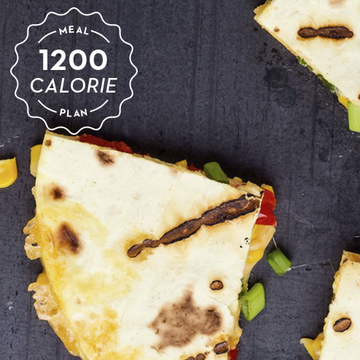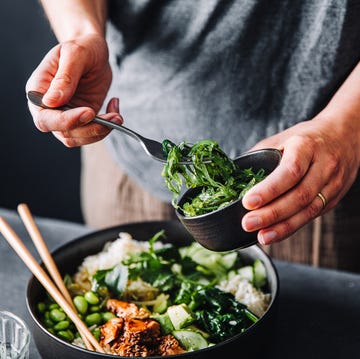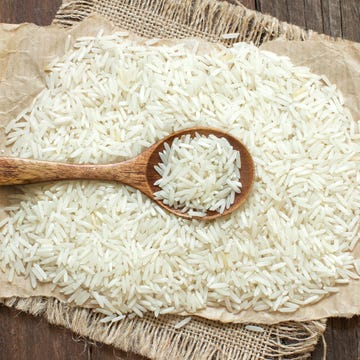Dietitians like Dawn Jackson Blatner, RDN, CSSD, have spent a lot of time lately answering questions from clients who are panicking about protein powder. The reason? Consumer Reports recently announced that they found concerning amounts of toxic lead in protein powders and shakes.
The bad news hit at a time when many of us are using supplements to hit our protein goals. “The trend is protein everything right now,” Blatner says. “Most people that I see, most people I know, are trying to get more protein.”
Experts say protein powder can still be part of a healthy diet. However, depending on which types you buy and how often you consume them, you might want to reassess your supplement strategy. Here’s what to know.
What did the investigation find?
Consumer Reports tested 23 popular protein powders and ready-to-drink protein shakes sold at supermarkets, health food stores, and online retailers such as Amazon and Walmart.
To search for lead, they used an analytical technique that identifies chemical elements within samples of material. They set 0.5 micrograms per day as their level of concern for lead exposure, based on the maximum daily dose under California’s Prop 65 law.
About 70% of products tested contained more than 120% of the daily lead limit. Most plant-based protein products had elevated lead levels.
Consumer Reports recommends avoiding two of the products they tested. The worst offender was Naked Nutrition’s Vegan Mass Gainer in Vanilla. It had 6.31 micrograms of lead per serving, which is 1,572% of the 0.5-microgram threshold. Huel’s Black Edition powder contained 6.3 micrograms of lead, about 1,290% of the daily limit.
For the other protein supplements, Consumer Reports recommended a maximum number of weekly servings based on each product’s lead levels. They said the following picks are better choices for daily use:
- Owyn Pro Elite High Protein Shake, Chocolate
- Transparent Labs Mass Gainer in Sweet Vanilla
- Optimum Nutrition Gold Standard 100% Whey in Chocolate
- BNS Syntha-6 Protein Powder in Vanilla Ice Cream
- Momentous Whey Protein Isolate in Vanilla Flavor
- Dymatize Super Mass Gainer in Gourmet Vanilla
- Muscle Tech 100% Mass Gainer in Vanilla Milkshake (the only product with no detectable lead)
Why is lead in protein powder,?
This isn’t the first time lead has been spotted lead in protein powder. In fact, earlier this year, the Clean Label Project also found lead in most of the protein powders they tested.
Lead can make its way into food through contaminated soil and also processing equipment and materials. When it comes to protein powder, plant-based products such as pea, hemp, and brown rice proteins are more commonly tainted with lead than animal-based options such as whey and casein. Chocolate-flavored powders tend to have more lead than vanilla ones.
“Ultimately, this issue is part of a broader conversation about our planet, our soil, and our food supply,” says Stefani Sassos, M.S., R.D.N., NASM-CPT, the Good Housekeeping Institute's Nutrition & Fitness Director.
How much lead is too much?
While no lead exposure is safe, the 0.5-microgram threshold used by Consumer Reports is much lower than the 8.8-microgram limit for females of childbearing age set by the U.S. Food and Drug Administration, reflecting a more precautionary approach, Sassos says. “The 0.5 micrograms lead limit is super strict, and it’s almost impossible to hit zero because plants naturally pull minerals from the soil they grow in,” she explains.
Lead exposure is particularly concerning for vulnerable populations, including pregnant women and children. In kids, lead can damage the brain and nervous system and cause learning and development, hearing, and speech problems. In adults, lead poisoning can cause a wide range of symptoms, such as joint pain, headaches, and difficulty concentrating.
The good news is that for most healthy adults, it would take repeated exposure to far greater daily amounts of lead to cause toxic effects, Sassos says.
How can I minimize lead if I use protein supplements?
There are a few fairly simple ways to minimize your lead exposure, even if you consume protein powder regularly.
1. Pick supplements verified by third parties.
“The most important thing is to look for protein powders with solid third-party certifications for purity, potency, and safety, like NSF Certified for Sport,” Sassos says.
Third-party testing organizations like NSF and Informed Choice check products for lead. They might not adhere to the strict 0.5-microgram standard of Consumer Reports, but “it’s still better than not testing,” says Blatner. She recommends contacting your favorite brands through their website and asking them to send you their heavy metal and lead lab test reports.It’s a good sign if they respond and share information, she says.
2. Stick to one serving or less per day.
“If you’re just using a third-party tested protein powder occasionally, there’s really no need to stress,” says Sassos. Up to one serving a day is fine.
“However, if you're consuming multiple scoops per day, a mass gainer powder (which is such a large serving size, often 6 to 7 scoops), or if you're also consuming foods fortified with protein powder, I'd reassess your diet,” says Angie Asche, MS, RD, CSSD, the owner of Eleat Sports Nutrition.
Another thing to consider is that many ultraprocessed foods, such as chips, pizza, and cookies, now have added protein powder. Or, people add it themselves. “People who live on Instagram and TikTok realized that you could put protein powder in literally everything,” says Blatner. “They're making pancakes in the morning with protein powder. They're making cookies in the afternoon with protein powder. They're stirring protein powder in their afternoon yogurt. They're putting protein powder as a protein powder shake. They're doing protein powder in their lasagna.” If that sounds like you, ask yourself—or your health care provider—if it's really necessary.
3. Rely more on whole food sources of protein.
“Protein powders are supplements, meant to fill gaps or literally supplement the diet rather than replace high-quality, nutritious foods,” says Sassos. “There are plenty of quick, whole-food options, like pre-grilled chicken, tuna pouches, single-serve yogurt or cottage cheese, and nuts, that you can incorporate into your diet.”
“The majority of my clients (and myself included) most often use protein powder in smoothies,” says Asche. “If you are wanting to swap this out for another whole food alternative that will still provide a good amount of protein in your smoothie, you could do Greek yogurt, cottage cheese, silken tofu, or use hemp seeds in combination with milk or soy milk.”
4. Rotate your products.
Stop ordering the same powder on repeat. “I like to switch up the trusted brands, because different brands do have different plants that they're putting in there,” says Blatner. “These different plants are grown in different soils, and you're going to get different lead levels from lower to higher.” Rotating can keep you from unintentionally using the same contaminated product every day.
That said, you may not want to change up your flavor options too much. “Stick to whey protein in vanilla or unflavored varieties rather than chocolate if you can,” suggests Sassos. These options tend to contain less lead.
The bottom line
Lead exposure is never safe, but you don't need to banish protein powder from your kitchen, especially if it's a small part of a balanced diet that also contains whole-food sources of protein. Be strategic about the products you buy, replace them with new ones every so often, consume it in moderation, and consider your whole diet.













